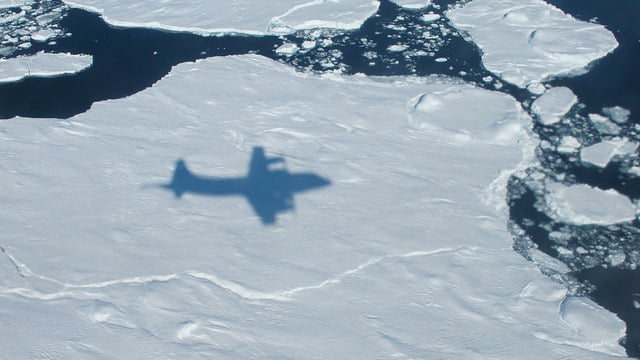There's a
"Chuck Norris fact"
that says Chuck once went skydiving but promised never to do it again, saying one Grand Canyon is enough. But Chuck must have taken another jump millions of years ago.
Data gathered by NASA's Operation IceBridge, an aerial science observation mission, has uncovered a previously unknown massive canyon in Greenland, hidden under a kilometer of ice.
The canyon, found by airborne radar data, has the same characteristics of a winding river channel like the Grand Canyon in Arizona. It is at least 750 kilometers (460 miles) long, making it longer than the Grand Canyon. In some places, it is as deep as 800 meters (2,600 feet), on scale with parts of the Grand Canyon. This immense feature is thought to predate the ice sheet that has covered Greenland for the last few million years.
"One might assume that the landscape of the Earth has been fully explored and mapped," said Jonathan Bamber, professor of physical geography at the University of Bristol in the United Kingdom, and lead author of the study. "Our research shows there's still a lot left to discover."
While additional airborne radar data was used, the majority of the data was collected by IceBridge flights over Greenland during flights from 2009 to 2013. IceBridge's Multichannel Coherent Radar Depth Sounder can see through vast layers of ice to measure its thickness and the shape of bedrock below.
In their analysis of the radar data, Bamber and his team discovered a continuous bedrock canyon that extends from almost the center of the island and ends beneath the Petermann Glacier fjord in northern Greenland.
At certain frequencies, radio waves can travel through the ice and bounce off the bedrock underneath. The amount of time the radio waves took to bounce back helped researchers determine the depth of the canyon. The longer it took, the deeper the bedrock feature.
The researchers believe the canyon plays an important role in transporting sub-glacial meltwater from the interior of Greenland to the edge of the ice sheet into the ocean. Evidence suggests that before the presence of the ice sheet, as much as 4 million years ago, water flowed in the canyon from the interior to the coast and was a major river system.
"It is quite remarkable that a channel the size of the Grand Canyon is discovered in the 21st century below the Greenland ice sheet," said Studinger. "It shows how little we still know about the bedrock below large continental ice sheets."
The IceBridge campaign will return to Greenland in March 2014 to continue collecting data on land and sea ice in the Arctic using a suite of instruments that includes ice-penetrating radar.
Bamber and his team had their findings published in the journal
Science.
Source:
NASA
 Universe Today
Universe Today
